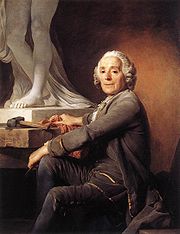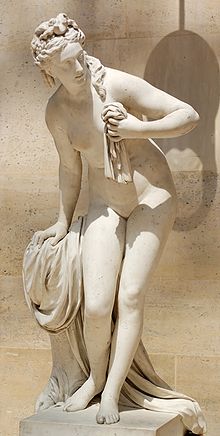
Christophe-Gabriel Allegrain
Encyclopedia


Paris
Paris is the capital and largest city in France, situated on the river Seine, in northern France, at the heart of the Île-de-France region...
– 1795) was a French sculptor who tempered a neoclassical style with Rococo charm and softness, under the influence of his much more famous brother-in-law, Jean-Baptiste Pigalle
Jean-Baptiste Pigalle
Jean-Baptiste Pigalle was a French sculptor.He was born in Paris, the seventh child of a carpenter. Although he failed to obtain the Grand Prix, after a severe struggle he entered the Académie Royale and became one of the most popular sculptors of his day.His earlier work, such as Child with Cage ...
.
Allegrain was born into a well-established family of landscape painters in Paris
Paris
Paris is the capital and largest city in France, situated on the river Seine, in northern France, at the heart of the Île-de-France region...
.
His single most famous work, a marble Bather (La Baigneuse), was commissioned for the royal residences through the Bâtiments du Roi
Bâtiments du Roi
The Bâtiments du Roi was a division of Department of the household of the Kings of France in France under the Ancien Régime. It was responsible for building works at the King's residences in and around Paris.-History:...
in 1755; a modelled sketch was shown at the Salon of 1757
Paris Salon
The Salon , or rarely Paris Salon , beginning in 1725 was the official art exhibition of the Académie des Beaux-Arts in Paris, France. Between 1748–1890 it was the greatest annual or biannual art event in the Western world...
. When the finished marble was finally exhibited at the Salon of 1767 it received a sensational reception. In 1772 Louis XV presented it to Mme du Barry for her Château de Louveciennes
Château de Louveciennes
The Château de Louveciennes in Louveciennes, in the Yvelines department of France, is composed of the château itself, constructed at the end of the 17th century. It was then expanded and redecorated by Ange-Jacques Gabriel for Madame du Barry in the 18th century, and the music pavilion was...
, where she had recently completed the famed pavilion that introduced the new Neoclassicism
Neoclassicism
Neoclassicism is the name given to Western movements in the decorative and visual arts, literature, theatre, music, and architecture that draw inspiration from the "classical" art and culture of Ancient Greece or Ancient Rome...
, usually associated with the "Louis Seize style", into court circles. After the King's death she was pleased enough with it to commission from Allegrain a pendant bather in 1776, which he delivered in 1778 (illustration). presented in the landscape garden as Vénus and Diane they provided an allegory of her past sensual love and her present chaste condition. (Both are conserved in the Louvre Museum.) There are small-scale patinated bronze reproductions, and both pieces remained popular and often reproduced through the nineteenth century: in 1860, when the Goncourt brothers
Goncourt brothers
The Goncourt brothers were Edmond de Goncourt and Jules de Goncourt , both French naturalist writers. They formed a partnership that "is possibly unique in literary history...
referred to "the refined legs of a Diana of Allegrain", their readers conjured up the familiar image.
His portrait by Joseph Duplessis
Joseph Duplessis
Joseph-Siffred Duplessis was a French painter, known for the clarity and immediacy of his portraits.He was born in Carpentras, near Avignon, into a family with an artistic bent and received his first training from his father, a surgeon and talented amateur, then with Joseph-Gabriel Imbert , who...
, 1774, earned the painter a place in the Académie Royale de Peinture et de Sculpture. Among his pupils were his son and François-Dominique-Aimé Milhomme. He died in Paris.

